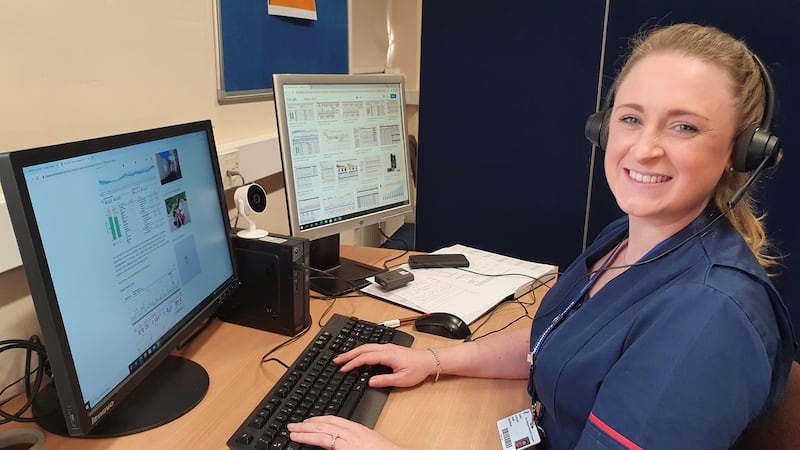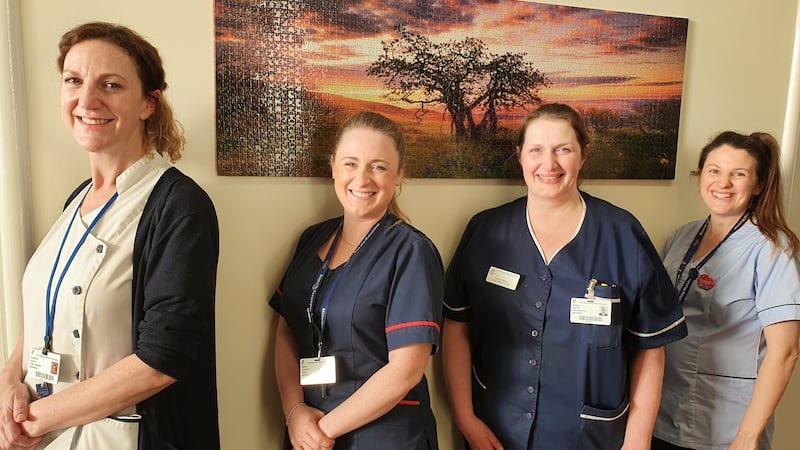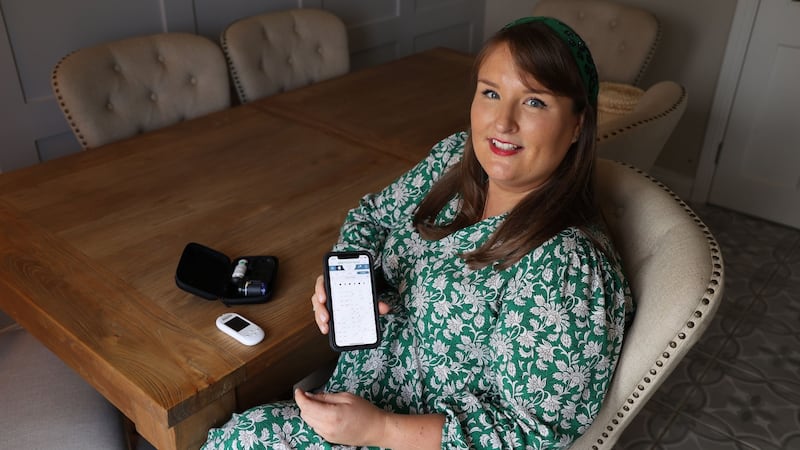A diagnosis of gestational diabetes usually comes out of the blue for the estimated 7,000-plus mothers-to-be in Ireland affected every year by this complication in pregnancy.
They probably won’t have experienced any symptoms at the time of diagnoses from a condition that increases health risks to both mother and baby. Pregnancy hormones always cause glucose to build up in the blood but, for most women, their pancreas will adapt and produce enough insulin to cope.
However, that’s not the case in women who develop gestational diabetes (GD); either not enough insulin is produced or it is not used efficiently, leading to high blood glucose levels. Untreated, this may cause problems such as pre-eclampsia, an over-large baby with associated birth difficulties, stillbirth, premature labour and low blood sugar in the newborn.
So it’s an extra worry for this group of women who, on diagnosis of GD, are classed as having a high-risk pregnancy and need careful monitoring and psychological support. Generally the diagnosis is made after women identified with risk factors such as a family history of diabetes, older maternal age, excessive sugar in the urine and a BMI of more than 30, take a glucose tolerance test at 24 weeks.
At the National Maternity Hospital (NMH) in Holles Street, where there are more than 8,000 births a year, staff would expect to see about 20 newly diagnosed cases of GD a week. They're monitored by a multidisciplinary team who also look after women who had pre-existing diabetes – either type 1 or type 2 – going into pregnancy.

As the Covid-19 pandemic began to encroach on Ireland in early March 2020, heralded by shocking images from Italian hospitals, the NMH diabetes team had an emergency meeting to discuss how they were going to manage to continue to care safely for this vulnerable group of mothers-to-be.
"Maternity could not stop," says Ciara Coveney, a registered advanced midwife practitioner at the NMH. There was no question of cancelling appointments; women had to be seen.
“It was a Friday,” she recalls, when the team, consisting of midwives, dietitians, endocrinologists, obstetricians and administration, gathered for an impromptu meeting. At the time, there were about 100 people in for their clinic, crowded into a small waiting room in the hospital. They knew that couldn’t go on amid rampant Covid-19.
The challenge was to decide which women could be cared for remotely, and how, and who would continue to need in-person appointments. From that moment, Coveney and her colleagues started to build a midwifery-led diabetes virtual clinic that has transformed the care of women with GD, resulting in a much better system than pre-Covid.
The level and speed of innovation, she acknowledges, would probably not have been possible in normal times due to red tape and lengthy assessment processes. But the imperative to keep women as safe as possible and reduce numbers coming into the hospital accelerated the changes.

Understanding GD, which can often be managed through food and exercise and not require medication, is vital for the newly diagnosed. The team quickly recorded an online version of the three-hour class that was usually run for new patients once a week in the hospital.
However, “we found that women didn’t respond particularly well to pre-recorded things”, says Coveney. “They need to feel someone is invested in their care, they need somebody at the end.”
A live class, delivered by a specialist midwife and senior dietitian through Webex video conferencing, was set up instead. Women were able to interact and raise queries. Over time, the three-hour presentation was fine-tuned to a webinar of about 40 minutes, covering the most pertinent points, followed by an opportunity for questions. An initial non-attendance rate of 70 per cent has now been reduced to 7 per cent, she reports.
“People were working from home, they were home schooling – you couldn’t ask them for more time than they were able to give.” Virtual clinical consultations were also set up very quickly, enabling women to see a midwife and dietitian to review their progress from home, instead of trekking into the hospital to see them every three weeks or so.
Daily multiple blood sugar readings underpin the management of GD and women use glucometers at home to record their levels. They used to be asked to log these in a diary to bring into the clinic, which was time consuming and a bit hit and miss.
With the rapid move to online clinics, they were asked to fill in online forms and email their readings for review in advance of the Friday consultations. But “it just didn’t work”, says Coveney. Between blank emails and some flagging serious clinical concerns that were arriving late on a Friday night, staff realised they had to be able to get these readings in a more reliable way but “with the least amount of hassle” for the women.
The adoption of Bluetooth-enabled meters, used in conjunction with a phone app, was the big breakthrough here. It automatically records all the readings for the women and allows the data to be downloaded by the hospital team. These glucometers can also be set to operate in any language.
Now, before Coveney does a consultation, she is much better informed to conduct that review by being able to look in advance at the woman’s charts and all her blood glucose readings. When necessary, interpreters can come in on the online session.
Case study: ‘It’s all to do with how my body reacts to sugar’
Sarah Cooke-O’Neill, who lives in Rathnew, Co Wicklow, is one of the women who has benefitted from the new system, both ahead of the birth of her son, Christopher, in September 2020, and also now that she is pregnant again. She attributes her GD to polycystic ovary syndrome, with which she was diagnosed at the age of 18. There is also a family history of diabetes.

Before I was on the insulin, I was exhausted. I'd eat something and 10 minutes later I would be falling asleep
“It’s not by choice that I am curvy, it is all to do with how my body reacts to sugar,” she says, believing she should have been put on the medication metformin after her polycystic ovary syndrome was first identified 20 years ago. The diagnosis of GD came 20 weeks into her last pregnancy, when she was asked rather sternly, she says, by a NMH midwife why she hadn’t already got a diabetes test done.
“I didn’t know I was supposed to,” was the answer. A glucose tolerance test indicated her body wasn’t managing her blood sugar levels well. After a full assessment at the diabetes clinic, she was asked to keep a food diary that could be reviewed in conjunction with blood readings, so dietitians could see if the condition could be controlled through food tweaks and exercise.
The team was “on it like a bonnet” she says, monitoring her remotely through Bluetooth on her phone. “If anything was up or wasn’t right, they would be calling me.”
She needed to prick a fingertip first thing in the morning, and then an hour after every meal, to deposit a “dew drop” of blood on the test strip in the glucometer. “About 70 per cent of women will be able to manage gestational diabetes in pregnancy through slight changes in diet and with 30 minutes’ physical activity a day,” says Coveney.
However, in Cooke-O’Neill’s case, the taking of metformin proved necessary “and that worked perfectly for me”, she says. All was well until, near the end, she developed life-threatening Hellp syndrome, necessitating an emergency Caesarean section at 38 weeks.
The effects of this complication first hit her during a trip to a supermarket, making her feel initially as if she was hungover. “I was shaky, feeling out of it; I was dropping the basket all the time. I thought ‘this isn’t right’ and I started throwing up.”
She went into the NMH where high protein was recorded in her urine and she was admitted to the day ward. After more tests, she was diagnosed with Hellp syndrome and told the baby had to be delivered that night, two weeks early. “I was done with his kicking anyway,” she jokes. After her husband, Ryan, had time to make it to the hospital, their son was delivered safely weighing 2.9kg (6.5lb). His blood was checked on arrival and her glucose levels stabilised over the days after delivery although, a week on, testing indicated she was insulin resistant. While this form of diabetes disappears after a woman gives birth, it is a strong indicator that she is at higher risk of developing type 2 diabetes in the future, as is her child.
Cooke-O’Neill, who is now 14 weeks pregnant, says she gained weight after having Christopher. “I walked 10km every two days and I tried to live by a ketogenic diet but the weight was slowly just tick, tick, ticking on. My insulin resistance might have been a bit worse than I thought it was and gaining that weight didn’t help.”
When she booked in with a GP, just four weeks into this pregnancy, she was advised to contact the NMH diabetes clinic straight away. They immediately sent her a glucometer and she has been monitored since. As metformin is not recommended before 14 weeks, she was put on two types of insulin that she will continue to take throughout. “I feel fine. Before I was on the insulin, I was exhausted. I’d eat something and 10 minutes later I would be falling asleep. That was my body trying to cope with the sugar.”
She would like to say to anyone diagnosed with gestational diabetes that, “although it sounds like a death knell when you hear it, the way they monitor it, it is nothing to worry about”.
One of the advantages is that partners can be with the women during consultations and ask questions
Diabetes is very suitable for remote monitoring and remote patient care, says Coveney and women are very happy with the new system. Some will continue to require face-to-face care and that is still provided in the diabetes clinic. “I thought it would suit fewer women than it does. I thought I would be doing a lot more face-to-face but women really enjoy it.” One of the advantages is that partners can be with the women during consultations and ask questions.
As so much of the treatment revolves around food and meals, it is nice, Coveney adds, for the partner to be able to be there and lend their support through this process. “That’s something you don’t get in the hospital.”
Read: Pregnant women should be tested for gestational diabetes




















